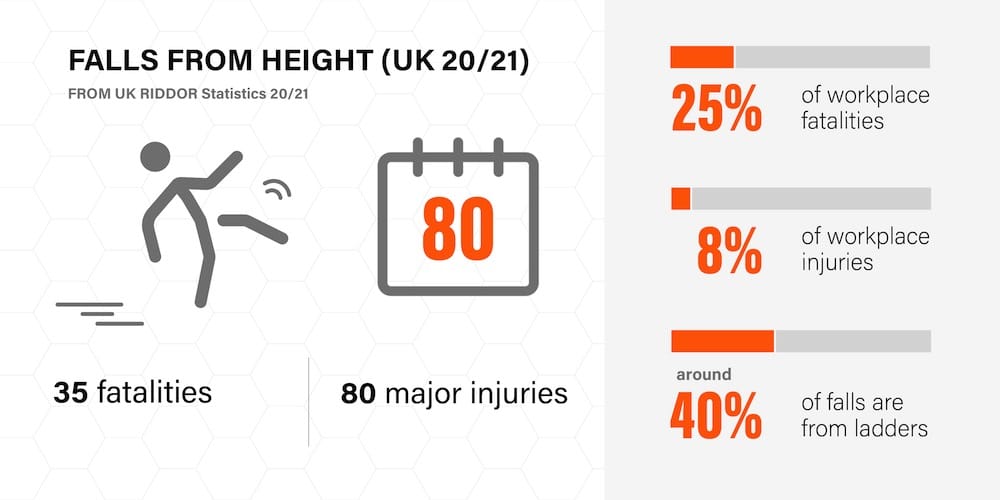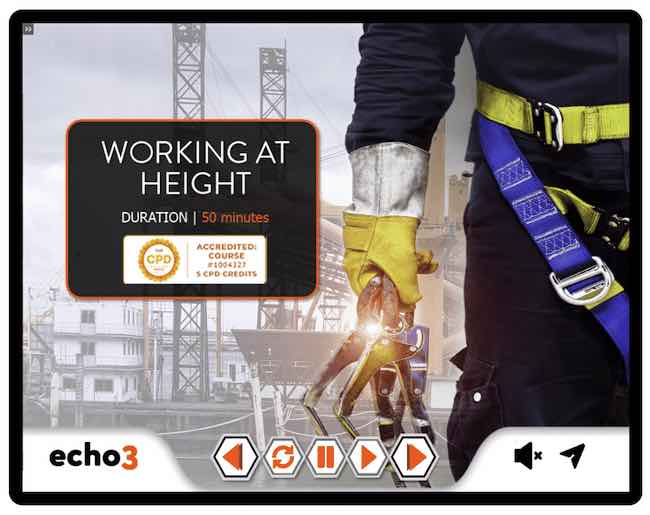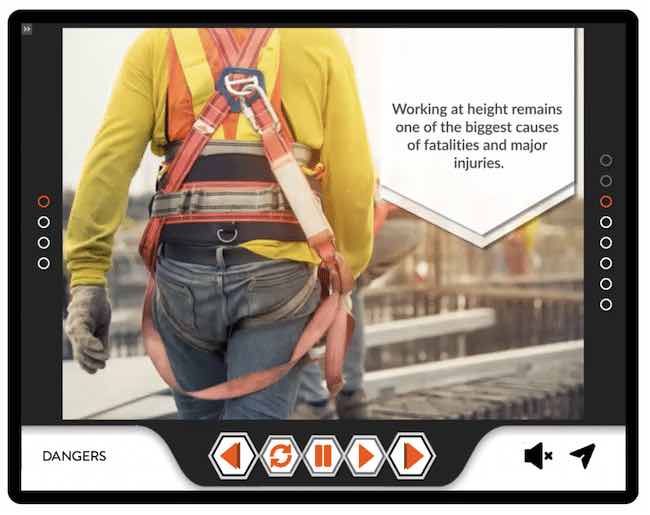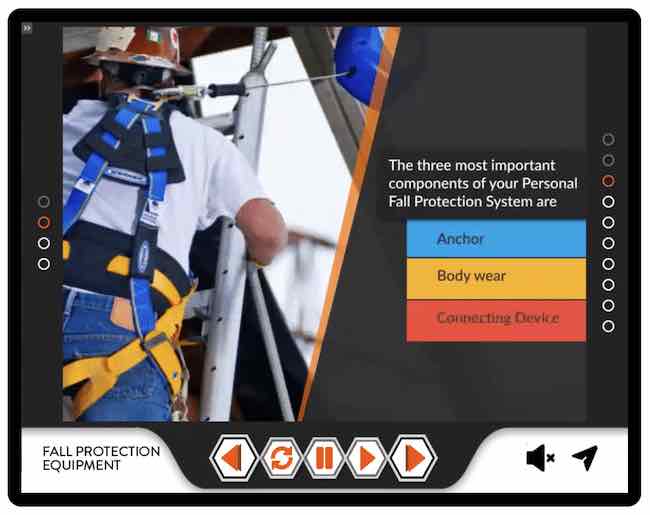Your basket is currently empty!

Working At Heights
Working at Heights online course designed for everyone working at heights or supervising those that do. This WaH training provides the knowledge needed to work at heights safely.
DURATION :
60 minutes
VALID FOR :
ACCREDITED BY :
WORKING AT HEIGHTS TRAINING
 Working at Heights online course develops the competence to work safely at height.
Working at Heights online course develops the competence to work safely at height.
Working at Height is defined as ‘work in any place where a person could fall and injure themselves’.
Over the RIDDOR reporting period 2022/2023, 40 employees lost their lives due to falls from height. This accounts for 30% of all UK workplace fatalities.
It is essential that employers ensure staff are competent to work at height safety. This also a legal requirement (Working at Height Regulations 2005).
The Echo3 Working at Heights course provides comprehensive training on hazard identification, the proper use of equipment, and safety protocols. Understanding regulations and best practices significantly reduces the risk of accidents.
The online Echo3 Working at Heights training offers flexibility allowing learners to study at their own pace. This CPD Working at Height certification includes an emailed certificate.
COURSE OBJECTIVES
 The course objectives of the online working at heights training include.
The course objectives of the online working at heights training include.
- Legal Compliance. Understand legal obligations and compliance standards related to working at heights.
- Safety Standards. Understand safety regulations and protocols specific to working at heights.
- Hazard Identification. Identify potential hazards present while working at height.
- Equipment Familiarity. Know about proper use, storage and maintenance of safety equipment like harnesses and ladders.
- Risk Mitigation. Know how to mitigate risks and prevent accidents.
- Emergency Procedures. Learn appropriate responses to emergencies including suspension trauma.
- Certification. Obtain certification demonstrating safety knowledge in working at heights, enhancing professional credentials.
WHO SHOULD TAKE THIS COURSE?

Everyone whose job involves working at heights or overseeing such operations must be competence. This online working at heights course provides the knowledge needed to work safely. Knowledge is an important part of competence, appropriate skills and experience are also required.
If you or your colleagues only work on ladders the online Ladder Safety course is more appropriate.
Remember, Working at Height is defined as ‘work in any place where a person could fall and injure themselves’. Even work a few inches of the ground is covered by the WaH regulations if there is a risk of falls and injury.
So various professionals across industries should consider taking a Working at Heights training online. This includes:
- Construction Workers. Those involved in building, maintenance, or repair work at elevated sites.
- Industrial Workers. People engaged in industries where working at heights is common, such as manufacturing or energy sectors.
- Maintenance Personnel. Individuals responsible for maintaining infrastructure like bridges, towers, or roofs.
- Window Cleaners. Professionals working on high-rise buildings.
- Telecommunication Technicians. Those involved in installing or repairing communication equipment on towers.
- Emergency Services Personnel. Firefighters or rescue workers who may need to operate at heights during emergencies.
- Health and Safety Officers. Professionals responsible for ensuring workplace safety.
- Supervisors and Managers. Individuals overseeing teams involved in tasks at elevated sites.
COURSE CONTENT
 UNIT 1 | INTRODUCTION
UNIT 1 | INTRODUCTION
Firstly, we provide a definition of working at height and highlight the applicable legislation. Then we identify the hazards and mitigating factors to consider. For example, weather, ground conditions, task duration, height, surfaces, and equipment.
UNIT 2 | SAFEGUARDS
Secondly, we detail the various safeguards in place to reduce the risks associated with working at height. These safeguards start with the hierarchy of control. Where working at height cannot be avoided, we outline best practice such as the use of anchor points and personal fall protection equipment (PFPE).
UNIT 3 | EMERGENCY CONSIDERATIONS
It is important to know what to do in the event of an emergency before your work commences. In this third section we highlight emergency considerations that help to ensure safety in the workplace. This includes suspension trauma, reflow syndrome, the dos and don’ts of fall protection.
UNIT 4 | LADDER SAFETY
Many injuries are caused due to the misuse of ladders. In this unit we look at what you need to know to work safety with ladders, including placement, pre-use checks, when ladders are appropriate, maintenance and storage considerations.
UNIT 5 | QUIZ
WORKING AT HEIGHT CERTIFICATE
At the end of the online Working at Heights training course there is a 20 question, multiple-choice quiz. If learners demonstrate their understanding of course content by achieving a minimum score of 80%, we’ll email them their completion certificate.
If learners score less than 80%, they can revisit any part of the course and retake the quiz until they are successful. A posted copy is available separately.
The Working at Heights certificate is valid for 3 years.

PLATFORM BENEFITS
 The Echo3 platform offers a number of benefits including.
The Echo3 platform offers a number of benefits including.
Flexible Administration. However your organisation works we can create an efficient administration workflow that fits your requirements.
Great Value. The Echo3 course platform offers great value online health and safety courses.
Trusted. The Echo3 platform is trusted by thousands of businesses with thousands of positive reviews. Our Working at Heights course also has had thousands of happy learners.
Scalability. Allows organisations to easily manage and deploy training programs for large groups, ensuring consistency and efficiency across teams.
Carbon Negative. Echo3 is a carbon negative business. Using our courses can help in turn reduce your businesses carbon footprint.
WHAT IS WORKING AT HEIGHTS?
Working at Heights regulations 2005 define Working at Heights as ‘work in any place where a person could fall and injure themselves’.
It’s worth noting that this does not include stairways or slips or trips on the same level where work is being performed.
Examples are:
- Work on a ladder, roof, scaffold, platform, etc.
- Somewhere there is a possibility you could fall through a fragile surface.
- Working in an area where there are potential risks, such as openings and holes in the floor.
- Working on a warehouse loading bay.
- Standing on a chair to change a lightbulb.
- Working above an inspection pit.
- Climbing plant and machinery to inspect or clean.
CONTACT
 If you have any questions about this Working at Heights course online, please email [email protected].
If you have any questions about this Working at Heights course online, please email [email protected].

 Working at Heights online course develops the competence to work safely at height.
Working at Heights online course develops the competence to work safely at height.
Working at Height is defined as ‘work in any place where a person could fall and injure themselves’.
Over the RIDDOR reporting period 2022/2023, 40 employees lost their lives due to falls from height. This accounts for 30% of all UK workplace fatalities.
It is essential that employers ensure staff are competent to work at height safety. This also a legal requirement (Working at Height Regulations 2005).
The Echo3 Working at Heights course provides comprehensive training on hazard identification, the proper use of equipment, and safety protocols. Understanding regulations and best practices significantly reduces the risk of accidents.
The online Echo3 Working at Heights training offers flexibility allowing learners to study at their own pace. This CPD Working at Height certification includes an emailed certificate.
COURSE OBJECTIVES
 The course objectives of the online working at heights training include.
The course objectives of the online working at heights training include.
- Legal Compliance. Understand legal obligations and compliance standards related to working at heights.
- Safety Standards. Understand safety regulations and protocols specific to working at heights.
- Hazard Identification. Identify potential hazards present while working at height.
- Equipment Familiarity. Know about proper use, storage and maintenance of safety equipment like harnesses and ladders.
- Risk Mitigation. Know how to mitigate risks and prevent accidents.
- Emergency Procedures. Learn appropriate responses to emergencies including suspension trauma.
- Certification. Obtain certification demonstrating safety knowledge in working at heights, enhancing professional credentials.
WHO SHOULD TAKE THIS COURSE?

Everyone whose job involves working at heights or overseeing such operations must be competence. This online working at heights course provides the knowledge needed to work safely. Knowledge is an important part of competence, appropriate skills and experience are also required.
If you or your colleagues only work on ladders the online Ladder Safety course is more appropriate.
Remember, Working at Height is defined as ‘work in any place where a person could fall and injure themselves’. Even work a few inches of the ground is covered by the WaH regulations if there is a risk of falls and injury.
So various professionals across industries should consider taking a Working at Heights training online. This includes:
- Construction Workers. Those involved in building, maintenance, or repair work at elevated sites.
- Industrial Workers. People engaged in industries where working at heights is common, such as manufacturing or energy sectors.
- Maintenance Personnel. Individuals responsible for maintaining infrastructure like bridges, towers, or roofs.
- Window Cleaners. Professionals working on high-rise buildings.
- Telecommunication Technicians. Those involved in installing or repairing communication equipment on towers.
- Emergency Services Personnel. Firefighters or rescue workers who may need to operate at heights during emergencies.
- Health and Safety Officers. Professionals responsible for ensuring workplace safety.
- Supervisors and Managers. Individuals overseeing teams involved in tasks at elevated sites.
COURSE CONTENT
 UNIT 1 | INTRODUCTION
UNIT 1 | INTRODUCTION
Firstly, we provide a definition of working at height and highlight the applicable legislation. Then we identify the hazards and mitigating factors to consider. For example, weather, ground conditions, task duration, height, surfaces, and equipment.
UNIT 2 | SAFEGUARDS
Secondly, we detail the various safeguards in place to reduce the risks associated with working at height. These safeguards start with the hierarchy of control. Where working at height cannot be avoided, we outline best practice such as the use of anchor points and personal fall protection equipment (PFPE).
UNIT 3 | EMERGENCY CONSIDERATIONS
It is important to know what to do in the event of an emergency before your work commences. In this third section we highlight emergency considerations that help to ensure safety in the workplace. This includes suspension trauma, reflow syndrome, the dos and don’ts of fall protection.
UNIT 4 | LADDER SAFETY
Many injuries are caused due to the misuse of ladders. In this unit we look at what you need to know to work safety with ladders, including placement, pre-use checks, when ladders are appropriate, maintenance and storage considerations.
UNIT 5 | QUIZ
WORKING AT HEIGHT CERTIFICATE
At the end of the online Working at Heights training course there is a 20 question, multiple-choice quiz. If learners demonstrate their understanding of course content by achieving a minimum score of 80%, we’ll email them their completion certificate.
If learners score less than 80%, they can revisit any part of the course and retake the quiz until they are successful. A posted copy is available separately.
The Working at Heights certificate is valid for 3 years.

PLATFORM BENEFITS
 The Echo3 platform offers a number of benefits including.
The Echo3 platform offers a number of benefits including.
Flexible Administration. However your organisation works we can create an efficient administration workflow that fits your requirements.
Great Value. The Echo3 course platform offers great value online health and safety courses.
Trusted. The Echo3 platform is trusted by thousands of businesses with thousands of positive reviews. Our Working at Heights course also has had thousands of happy learners.
Scalability. Allows organisations to easily manage and deploy training programs for large groups, ensuring consistency and efficiency across teams.
Carbon Negative. Echo3 is a carbon negative business. Using our courses can help in turn reduce your businesses carbon footprint.
WHAT IS WORKING AT HEIGHTS?
Working at Heights regulations 2005 define Working at Heights as ‘work in any place where a person could fall and injure themselves’.
It’s worth noting that this does not include stairways or slips or trips on the same level where work is being performed.
Examples are:
- Work on a ladder, roof, scaffold, platform, etc.
- Somewhere there is a possibility you could fall through a fragile surface.
- Working in an area where there are potential risks, such as openings and holes in the floor.
- Working on a warehouse loading bay.
- Standing on a chair to change a lightbulb.
- Working above an inspection pit.
- Climbing plant and machinery to inspect or clean.
CONTACT
 If you have any questions about this Working at Heights course online, please email [email protected].
If you have any questions about this Working at Heights course online, please email [email protected].










